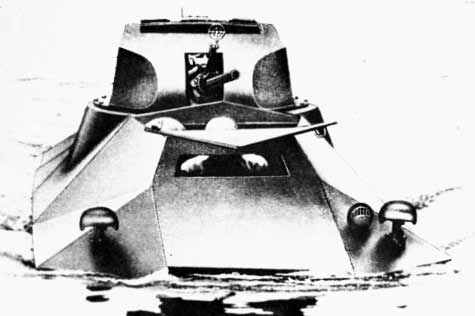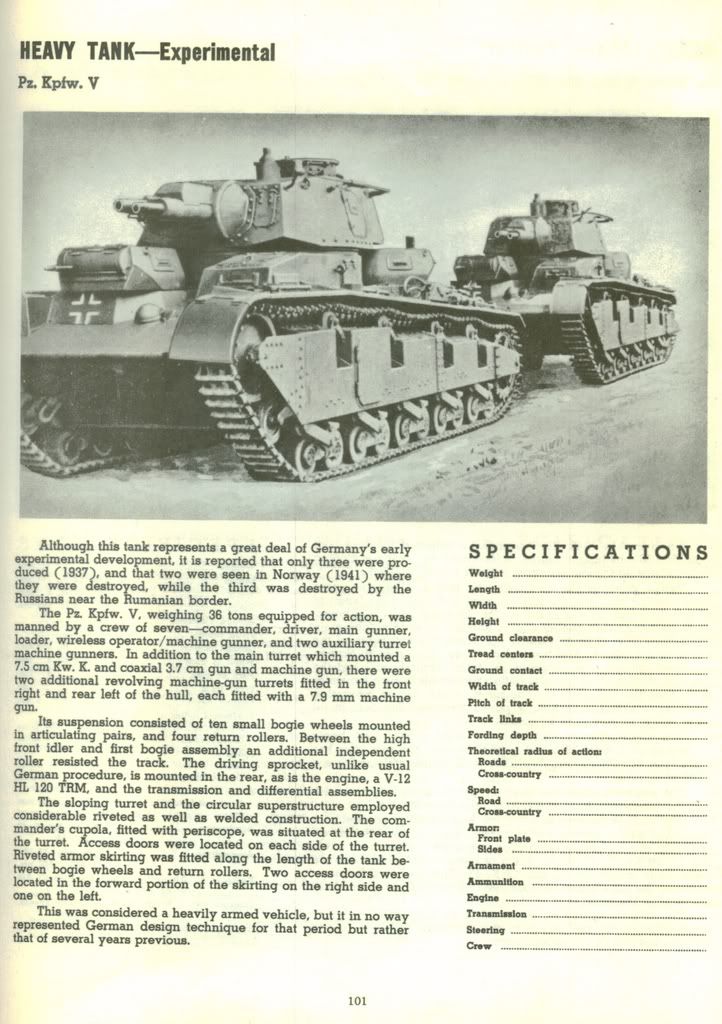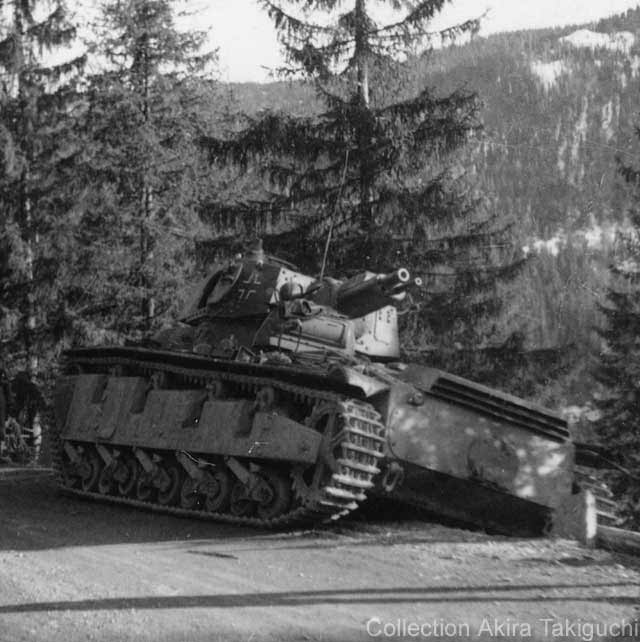German Armored rarities (book) Waffen arsenal band 10.
An interesting self propelled howitzer with a 360 º traverse.

Extracted from: Enciclopedya of German tanks.
Panzerspähwagen Schildkröte I, II und III
Three prototype four-wheeled amphibious armored cars - Schildkröte (Turtle) I, II and III were designed by Hans Trippel in 1941 and build by Trippelwerke at Molsheim in October of 1942.
The vehicles were powered by an 125 hp V8 Tatra air-cooled engine. It had good performance on the road and in the water being the Sch III the most powerful of the series with an 20 mm gun. This was not the Kwk 38 from the panzer but a an aeronautical MG-151/20 cannon.

Mg-151/20 with open sights.

However the requeriments for flotation ( an obvious characteristic in an amphibious vehicle) means that the armor was to be light with a maximum of 10 mm . The Waffeamnt did not like that characteristics and decide to not purchase the vehicle.
Schildkröte III in water.

Panzerspähwagen Trippel E3 / E3M
In 1943 and 1944, based on Schildkröte III, new Panzerspähwagen Trippel E3 (E = Einheits = Standard) series was built. Only three prototypes were build including single turretless E3M ammunition carrier. The armor was between 5.5-14.5mm In October of 1944, Waffenamt decided that such vehicles were not needed.
Turretless prototipe.

VK1601 (panzer II ausf J )
The VersuchsKetten 1601 (experimental fully tracked vehicle 16 tons model 01) was a tank slightly based on the Panzer II. The object was to improve the armor and therefore the survivality in the battefield. In order to do so the frontal armor was 80 mm and 50 mm in the side hull /turret. This tank copied the crew layout in the Pz II , with an Tank commander/gunner/ loader, radio operator and driver.

The delopment for an “0” series was issued in december 1939, development of the chassis was entrusted ton MAN and the turret went to Daimler-Benz. The fisrt VK1601 was completed in June 1940.
This tank had an interleaved suspension of similar desing to the prototipe “VK901” but more strongly built in order to support the aditional weight. The hull and the superestructure was buil as one unit ( A departure from the german practice up to this time wich was a bolted superestructure.)

In total 22 VK1601 were manufactured between April - December 1942, The “ausf J” designation was a extraoficial one used mostly by the soldiers. The armament being a 20 mm automatic KwK 38 gun and a 7,92mm MG-34 with 2150 AP bullets. The turret was traversible only by hand.
Bergenpanzer II ausf J.

Seven VK 1601 (Ausf J) were issued to 12th Panzer Division, which was fighting on the Eastern Front. In 1944, one of them was converted into a recovery vehicle - Bergepanzer II Ausf J. Later on in 1944/45, the same vehicle served with Panzer Werkstatt Kompanie (Tank Repair Company) of 116th Panzer Division.

VersuchsKetten VK601 & 602 ( Panzer 1 neuer art ausf C)

On September 15th 1939 the ordnance department was given the order to get a light reconnaissance tank developed with enhanced armor than Pz 1 A. The company of Krauss-Maffei in Munich was responsible for making the chassis while Daimler-Benz got the responsibility for superstructure and turret. The project was known as VK601 or better known as Panzerkampfwagen I Na Ausf.C.
The engine in the proto was the Maybach HL45P with 150 metric hp, giving the vehicle a maximum speed of 65km/h.The tank commander/gunner had 8 periscopes in a tiny cuppola.
The appearance of the Ausf.C was completely different from the previous Ausf.A and B. The suspension features big interleaved wheels and torsion bar suspension with internal hidroneumatic shock absorvers. This really improve the mobility over bad terrain.
The crew of two men had as main armament a heavy machinegun EW141 machinegun and a coaxial MG34.
There is a lot of mistakes in the websites when describing the EW-141. Some say it was a 13mm gun some even describe it as a 20 mm cannon.
Actually this was a 7,92mm caliber Mauser desing originally called “MG-141” , the EW just mean "Einbauwaffe" or emplacement gun. This recoil operated gun use the large the cartrigdes of the Pzb 38 & 39 antiarmor rifles, it was a semiauto weapon with a muzzle velocity of 1180 m/s and could penetrate 26 mm of armor up to 100 meters in a vertical plate. So in that way the ausf C had a limited antitank capacity.
The weight was 8,1 tons, a length of 4.19m, width 1.92m and height of 2.01m. The power to weight ratio of 18.2hp/t was remarkable, which was one of the reasons for the high speed. With a length of 2.2m where track touches ground and a track width of 39cm resulted in a ground pressure of 0.46 kg/cm2. The track had 89 single track links, . The VK601 was able to wade up to 78.5cm deep, pass over 1.2m wide trenches and could climb 30cm high obstacles.

Before production some changes were introduced , including a some dry pin tracks wich have less mantainance that the lubricated ones. Also a more powerful engine HL61 was installed. bThe vehicle was now denominated VK602.
40 Panzer I Ausf.C were produced between July of 1942 and april 1943, of which two were delivered to 1st panzer division early in 1943 and troop tested in Russia.
The remaining 38 vehicles were taken to reserve units of the LVIII Panzer reserve Korps in France. Those came in action in 1944 in the battles in the Normandy.
Pz ausf 1 c in France , june 1944. The guns had a muzzle cover

This topic is dedicated to the multi-turret Panzer V experimental tank designed before the Panther. It was never mass-produced though, for it was to much like the T-35 - which was only basically used in parades…
I couldn’t find any info on this tank while surfing the web, but I did find this in one of my father’s ancient German Weapon’s of WW2 books…

By the way…
I wasn’t a messy cropper (For once! LOL), so there are actually no specifications. I guess everything except for the explanation is pretty much unknown.
i’m ashamed:cry: iv’e never heared of the panzer v experemental tank. ither way il’l keep looking.
Hi.
Make a search for “Neubaufahrzeug” or “Nbfz”/“Nb.Fz”.
Yours
tom! 
Same with this…



And here is a model of one…

The German Neubaufahrzeug series of tank prototypes were a first attempt to create a heavy tank for the Wehrmacht after Adolf Hitler had come to power. Multi-turreted, heavy and slow, they did not fit in with the Blitzkrieg tactics and there were only five made. These were primarily used for propaganda purposes, though three took part in the invasion of Norway in 1940.
Development of the Neubaufahrzeug (German for “new construction vehicle”) started in 1933 when the then Reichswehr gave a contract for the development of a ‘Großtraktor’ (heavy tractor) to both Rheinmetall-Borsig and Krupp. ‘Grosstractor’ was a codename for the development of a heavy tank, Germany being still forbidden to develop tanks under the terms of the Treaty of Versailles.
The two designs resembled each other to a great extent, the main difference being the weapons placement. Each had a main turret armed with a 75 mm KwK L/24 main gun and secondary 37 mm Tankkanone L/45, with Rheinmetall’s design mounting the second gun above the 75 mm KwK L/24, while the Krupp design had it mounted next to the 75 mm KwK L/24. Both designs had two secondary turrets mounted to the front and the rear of the main turret. These secondary turrets were slightly adapted Panzer I turrets, with the standard machinegun armament.
Rheinmetall’s design was designated the PzKpfw NbFz V (‘PanzerKampfwagen NeubauFahrzeug V’), and the Krupp design the PzKpfw NbFz VI. It was intended that these designs would fulfill the role of heavy tank in the armored forces, but the design proved to be too complex and unreliable for this role. Development nevertheless continued in order for the nascent German military to gain experience with multi-turreted tanks.
In 1934 Rheinmetall built two mild steel prototypes, the first armed with an in-house turret design, and the second with a Krupp turret. Three more prototypes were built with proper armor and the Krupp turret in 1935 and 1936.
Though these tanks were never placed in production, they provided a propaganda tool for Nazi Germany, for example being shown at the International Automobile Exposition in Berlin in 1939.
This propaganda role was extended with the German invasion of Norway, when a special panzerabteilung was formed which took the three armored prototypes with them to Oslo. They saw some combat there, with one being blown up by German engineers when it got stuck in swamps near Andalsnes. To replace it, one of the mild steel prototypes was used.
It is unclear what happened to the tanks after the Norway campaign, but none of them survived the war. The Surviving vehicles were ordered scrapped in 1941, which event took place in 1942 according to documents captured by the British in 1945. Unclear is the dates upon which the vehicles were scrapped, but it is thought that the beginning of the construction of the Grille prototypes (128 mm KwK44 L60 or L71 cannon on the Henschel Vk3001 and Vk3002 Chassis) dates from the same time. Certainly the two Grille were completed, one of which saw action against Russian troops near Kharkov, in both 1943 and 1944.
I think that the denomination “Panzer V” was only to propaganda purposes to made believe the british that the german Army had a new heavy tank.
Oh ok. Thanks! That makes sense now…
I like most of the tanks in the 1930s…people were still trying to discover new techniquse from WWI and a bunch of new designs floated up.
Panzerkampfwagen Skoda T-15.
In the late 1941 the German army was well aware that his standar reconnaissance armored cars and half tracks were no longer competitive in the Battlefield. That fact was particulary true in the Eastern Front place in wich they were exposed to a large quantity of artillery, mines and antitank rifles.
In order to adquire a more capable vehicle the Waffeamt issued a request for a fully tracked recce panzer wich should be capable to reach 40 km/h in cross country and to be armed with at list a 20 mm automatic gun and a MG.
The Skoda steel works, famous czech factory wich also made artillery and tanks, send his own proposal to germany. The projekt was admited and two prototipes manufactured.
T-15 wooden mock-up.

The T-15 was roughly similar to the Pz 38 (t) however it was constructed in a more rational manner. It used a completely rolled homogeneus armor wich was put togheter by electric welding. That was a serious improve about the earlier riveted armor, not only because made production faster and stronger assembly but also because it increase the security to the crew when the armor was hit.

The armament was comprised of a Kwk 38 (t) (Skoda A7) of 37 mm and 48 calibers in lenght, mounted coaxially a MG 34 panzerlauf was installed. The tank carried 80 rounds for his main gun and 2450 shots of armor piercing 7,92mm bullets for the machinegun.
A Praga V-8 liquid cooled petrol engine deliver 225 hp and with this the 10,7 tons tank could reach 53 km/h max. speed. The overall lenght was 4,9 metres. The armor was formed by 30 mmplates in the front, 25 mm sides and 20 mm rear.
The two T-15 protos were delivered to the Kummersdorf test facilities in may 1942, the vehicle was considered good but the Daimler VK 1303 had better radio equipment and cross country abilities so T-15 was not put in production.

Im not sure if any of u have seen or heard of the Grille Series of Anti Air and possibly tank destroyers. I think these were a great form of mobile air defense.
http://www.achtungpanzer.com/pz13.htm
This sweet looking version of the e-100 was being planned. its called the Flakzwilling 8.8cm Auf.E-100.
Dual mounted Flak 88’s were installed. Soviets discovered the blueprints in late 1945
heres the link to the page i found it on
http://members.tripod.com/~fingolfen/superheavy/fze100m.html
Thanks for the links.
[LEFT]
In the latter stages of World War II, Allied air superiority on all fronts severely hampered German forces, especially armor. Aircraft like the Sturmovik, Typhoon, and P-47 wreaked havoc among the Panzer Divisions. With the late-war interest in superheavy panzer like the Maus and E-100 (and one could also include the Tiger II and Jagdtiger in this category), the need for complimentary air defense was clear.
I believe that the 88 mm rate of fire was too slow firing for that task, in order to protect against low flying aircraft the 30-37mm automatic cannons would be better suited. Some like the Kugelblitz panzer that I ve posted in the early pages of this topic.
37 mm Flak 36.

[/LEFT]
Anybody has more informations about that vehicle?
That is quite interresting!! 
That extract from “German Armored rarities” is all I got.
Yea thats true, but also u could use them for AT role but it would of been cool to see a picture of that in action.
Cool… yes, practical ?.. probably not.
[LEFT]Flakpanzer auf Panzerkampfwagen II Ausf. L

This strange little vehicle represents Rheinmetall-Borsig’s first attempt to mount the 3.7cm FlaK43/1 L/60 on a fully-tracked chassis. The flak 43 was an simplier and improved rate of fire variant of the 37mm flak 36.

The Chassis is that of the Panzerkampfwagen II Ausf. L lengthened by two roadwheels. This arrangement was later used successfully on a Panzer IV chassis to create the Ostwind. Pz II 3,7 Flak projeckt did not advanced further than a mockup.
 [/LEFT]
[/LEFT]
